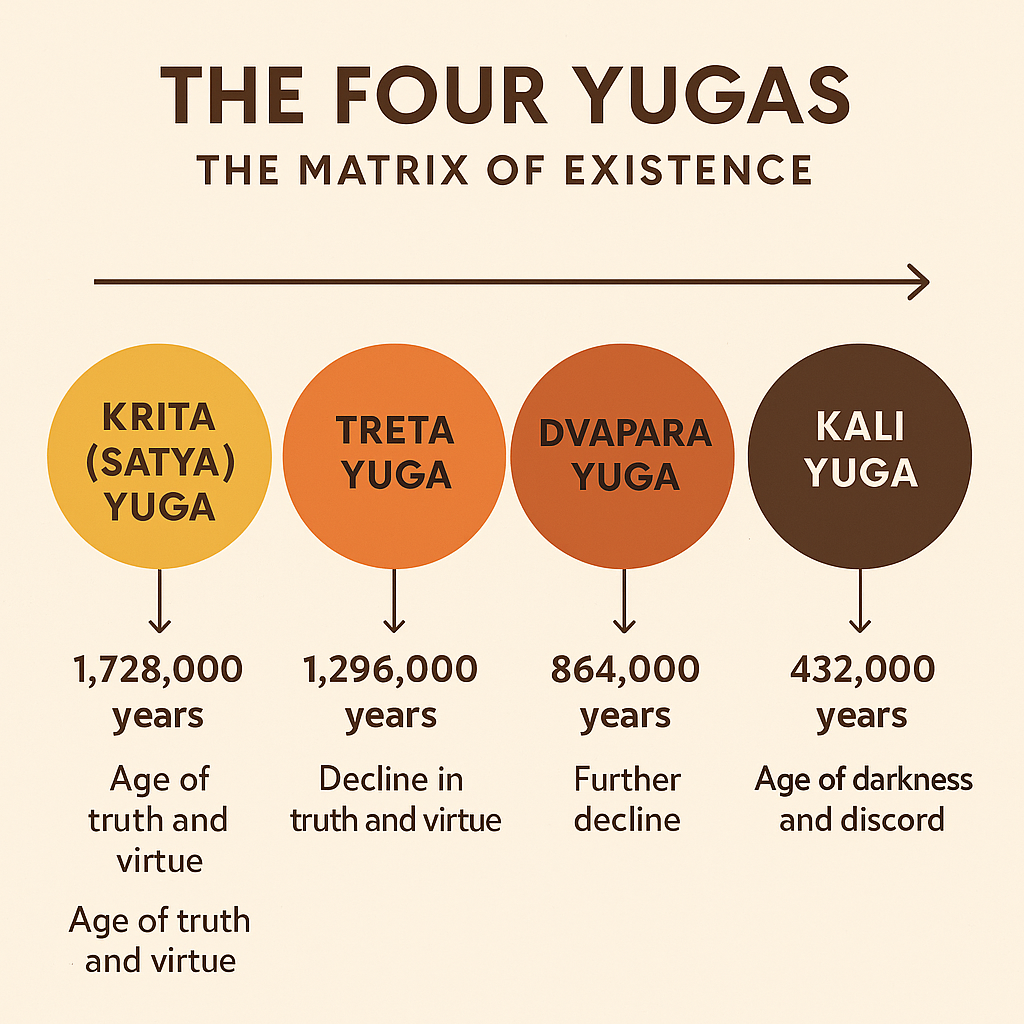The Matrix of Existence: The Four Yugas
Since the dawn of time, humanity has pondered the origin and destiny of the universe. Across civilizations, philosophical schools and spiritual traditions have tried to unravel the mysteries of existence and the nature of the human being.
In ancient India, sages had a remarkable awareness of the vastness of time and space. They measured time based on the cycles of the sun and moon. According to the Purana texts, existence unfolds in four great epochs or Yugas, each distinct in moral and spiritual quality. The names and durations of these epochs are symbolically derived from the dice game, each corresponding to a different throw of the dice.
These epochs are:
Krita or Satya Yuga – The Golden Age (1,728,000 years)
Treta Yuga – The Silver Age (1,296,000 years)
Dvapara Yuga – The Bronze Age (864,000 years)
Kali Yuga – The Iron Age (432,000 years)
Each age is shorter than the one before it, and this decline is mirrored in the gradual moral and spiritual degradation of humanity.
Krita Yuga (Satya Yuga): The Age of Truth
This era symbolizes perfect virtue. People live in harmony, and qualities such as kindness, compassion, and honesty dominate. Ignorance, greed, and deceit are almost nonexistent. According to Puranic texts, the Divine (Vishnu) is present in a fully realized form during this era. The karma ratio is 19 merits to 1 demerit.
Treta Yuga: The Age of Declining Virtue
Virtue begins to wane. One quarter of purity is lost, and conflict between virtue and vice begins. The Divine reveals itself once in this age, with triple potency. The karma ratio shifts to 15 merits for every 5 demerits.
Dvapara Yuga: The Age of Doubt and Decline
Virtue and vice are nearly balanced. Faith wanes, and secrecy and skepticism grow. The Divine manifests twice. The karma ratio becomes 7 merits to 13 demerits.
Kali Yuga: The Age of Darkness
This current age is marked by materialism, greed, ignorance, and loss of spiritual values. Only one quarter of the original purity remains. The Divine does not manifest directly. The karma ratio becomes 2 merits to 18 demerits.
This age ends with global upheaval—floods, storms, and a cosmic reset, after which a new cycle of creation begins. Together, the four Yugas form a Maha Yuga totaling 4,320,000 years. According to Indian sages, we are currently living in Kali Yuga.
One Maha Yuga equals one day of the Creator (Brahma). A full cycle of 14 Manvantaras (each containing 71 Maha Yugas) forms one ‘creation season.’ At the end of the Creator’s day comes the Creator’s night, also equal to one Maha Yuga. Thus, the universe endlessly cycles through creation and dissolution.
This profound vision of time urges us to reflect not only on the destiny of the cosmos but also on the quality of our thoughts, actions, and evolution in this great unfolding tapestry of existence.

